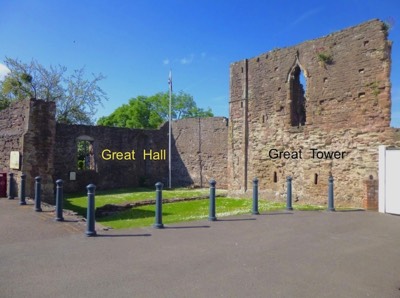Monmouth Castle Ruins
Today's meagre ruins give little insight into this once important early Norman castle which was built by William FitzOsbern, a nephew of the Conqueror, to protect the settlement beside the confluence of the Monnow and the Wye.
The first castle, dating from about 1068, would have consisted of a wooden tower inside an oval, ditched enclosure, with a surrounding timber palisade and gate. This was replaced in the 12th century when the curtain walls and the Great Tower were built in stone, to be followed in the next century by a Round Tower "of great height and strength".
During most of this early period the lordship was held by a family whose origin was Breton, rather than Norman. The rebel Simon de Montfort held the castle briefly, but then it passed to Edmund Crouchback (a son of Henry III, and 1st Earl of Lancaster) who added the Great Hall to house the royal courts. Later Edward II, the gay king, passed through as a prisoner on the way to his death at Berkeley. In the 14th century Henry of Grosmont refurbished the upper floor of the Great Tower to provide greater comfort, and it was probably there that Henry V was born in 1387. However details are vague because he was not a royal prince at birth, and the family were only visiting while on a tour of their estates.
The castle was in its heyday in the 15th century. The Great Hall, Great Tower and Round Tower looked over the Monnow, while a stone gate-house, a chapel, and a jail faced the town. But after the Wars of the Roses it fell into disrepair, as did most Norman castles. In the middle of the 16th century surveyors recorded the state of decay of both towers, the chambers and the chapel. They asked that the Gatehouse be repaired to make the jail secure, and to allow the King's auditors and tax collectors to work in comfort. Only the Great Hall had been kept in good repair, as the assizes were held within it.

In the Civil War the Castle changed hands three times (once by trickery) and there was a short siege during which the Great Tower was undermined. Cromwell's soldiers then demolished the Round Tower - and much of the undermined Great Tower collapsed soon afterwards. Twenty-five years later Great Castle House was built on the site of the Round Tower, using some of the old stones. The house is now the headquarters of the Royal Monmouthshire Royal Engineers, and so provides a rare example of a Norman castle fulfilling a modern military role.
Today only parts of the Great Hall (around the flagpole in the photo) and the Great Tower survive as the ruins. The earliest remains are at the base of the Great Tower, in the form of small slit-windows low down, and a primitive course of sloping stones higher up - features which contrast with the noble windows of the later upper storey. There are also traces of a staircase which rose to a doorway on the first floor because, for security, originally there was no entrance at ground level. To the south the single storeyed Great Hall has lost its north wall, revealing two large windows, one of which retains its mullion and transoms.

